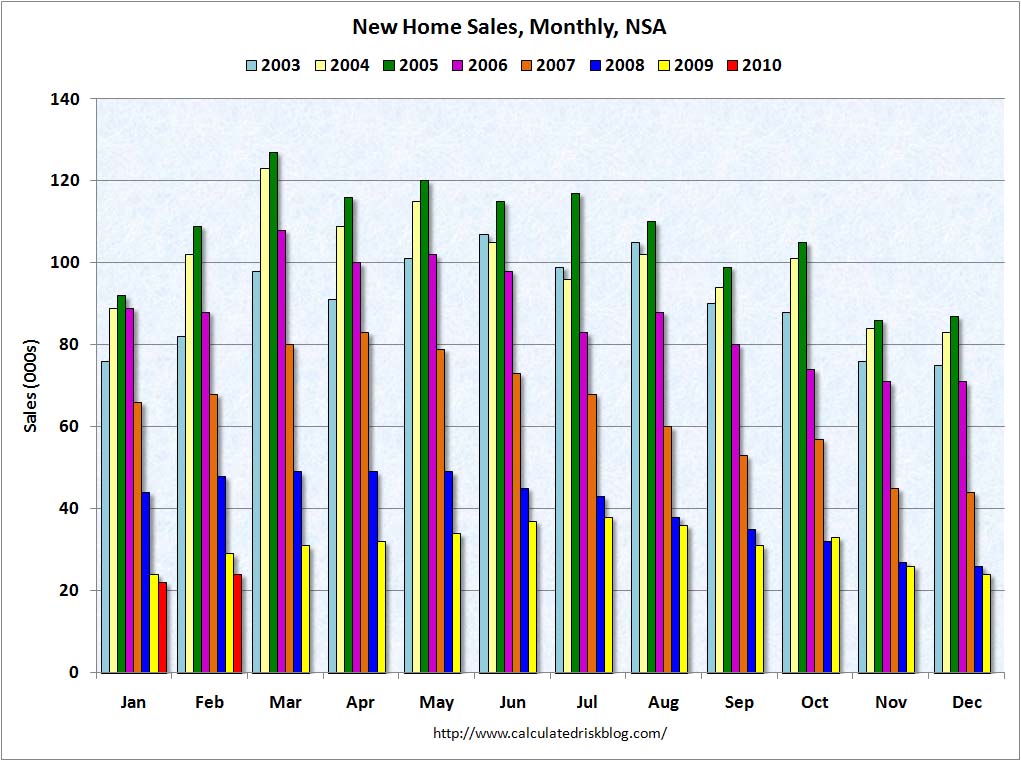American Dream 2: Default, then Rent
The housing market is back down, in both sales of new homes and existing homes. The crawling recovery in both housing market and labor market put a deep dent on American consumers’ wealth and income. The danger still exists that the U.S. will follow Japan into a lost decade.
(click to enlarge; graph courtesy of CalculatedRisk)
American Dream of owning a house will soon turn to (arguably, has already turned) Dream v2: “default, then rent”:
People’s increasing willingness to abandon their own piece of America illustrates a paradoxical change wrought by the housing bust: Even as it tarnishes the near-sacred image of home ownership, it might be clearing the way for an economic recovery.
Thanks to a rare confluence of factors — mortgages that far exceed home values and bargain-basement rents — a growing number of families are concluding that the new American dream home is a rental.
Some are leaving behind their homes and mortgages right away, while others are simply halting payments until the bank kicks them out. That’s freeing up cash to use in other ways.
The U.S home-ownership rate has charted its biggest decline in more than two decades, falling to 67.6% as of September from a peak of 69.2% in 2004. And more renters are on the way: Credit firm Experian and consulting firm Oliver Wyman forecast that “strategic defaults” by homeowners who can afford to pay are likely to exceed one million in 2009, more than four times 2007’s level.
Stiffing the bank is bad for peoples’ credit, and bad for banks. Swelling defaults could also mean more losses for taxpayers through bank bailouts.
Analysts at Deutsche Bank Securities expect 21 million U.S. households to end up owing more on their mortgages than their homes are worth by the end of 2010. If one in five of those households defaults, the losses to banks and investors could exceed $400 billion. As a proportion of the economy, that’s roughly equivalent to the losses suffered in the savings-and-loan debacle of the late 1980s and early 1990s.
(click to play the interactive graph of Strategic Default)
The flip side of those losses, though, is massive debt relief that can help offset the pain of rising unemployment and put cash in consumers’ pockets.
For the 4.8 million U.S. households that data provider LPS Applied Analytics estimates haven’t paid their mortgages in at least three months, the added cash flow could amount to about $5 billion a month — an injection that in the long term could be worth more than the tax breaks in the Obama administration’s economic-stimulus package.
“It’s a stealth stimulus,” says Christopher Thornberg of Beacon Economics, a consulting firm specializing in real estate and the California economy. “The quicker these people shed their debts, the faster the economy is going to heal and move forward again.”
As the stigma of abandoning a mortgage wanes, the Obama administration could face an uphill battle in its effort to keep people in their homes by pressuring banks to cut their mortgage payments. Some analysts argue that’s not always the right approach, particularly if it prevents people from shedding onerous debts and starting afresh.
“The effect of these programs is often to lead homeowners to make decisions that are not in their economic best interests,” says Brent White, a law professor at the University of Arizona who has studied mortgage defaults.
Housing market is still at depressed level
New homes built during the bubble are still not moving much; adding to the problem is the retreat of existing home sales, due to the expiration of housing credit.
The housing market still points to an anemic economic recovery for the US economy.
Graph courtesy of CalculatedRisk.


China has the most diabetics in the world
Report from WSJ. I was wondering how auto consumption has contributed to the increase. This is a sharp reminder that China should put developing better public transportation on the same importance level as developing its auto sector.
One in 10 Chinese adults have diabetes and another 16% are on the verge of developing it, according to a study published Thursday in the New England Journal of Medicine. The finding nearly equals the U.S. rate of 11%.
With 92 million diabetics, China is now home to the most cases world-wide, overtaking India. The survey found much higher rates than previous studies largely due to more rigorous testing measures. David Whiting, an epidemiologist at the International Diabetes Federation, who wasn’t involved in the study, said, “The rate of increase is much faster than we’ve seen in Europe and in the U.S.”
In China, many people are moving out of farms and into cities, where greater wealth has led to a sedentary lifestyle and sweeping diet changes, including heavily salted foods, fatty meats and sugary snacks. “As people eat more high-calorie and processed foods combined with less exercise, we see an increase of diabetes patients,’’ said Huang Jun, cardiovascular professor at the Jiangsu People’s Hospital in Nanjing who didn’t participate in the study.




![Reblog this post [with Zemanta]](https://img.zemanta.com/reblog_e.png?x-id=8e58cb77-e39e-49a8-b96a-90e6b9c63b56)